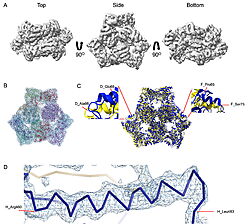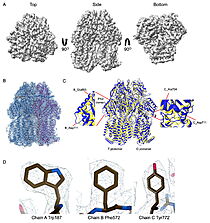Off-Target Structural Insights: ArnA and AcrB in Bacterial Membrane Protein Cryo-EM Analysis
Mehmet Caliseki, Ufuk Borucu, Sathish K. N. Yadav, Christiane Schaffitzel
and Burak Veli Kabasakal [1]
Molecular Tour
When cells build and maintain their membranes, they need a balance of protein insertion, folding, and degradation. In Escherichia coli, this process is hypothetic to involve the AAA+ protease FtsH, the insertase YidC, and the regulatory HflKC complex. Their interaction had not been shown at structural level. To test this idea, we used single-particle cryo-electron microscopy on detergent-solubilized samples enriched for these proteins.
The results were unexpected. Instead of clear views of an FtsH–HflKC–YidC assembly, the datasets revealed , an enzyme linked to polymyxin resistance, and , the multidrug efflux transporter of the AcrAB–TolC system. Both proteins are known to appear during affinity purification, but their repeated presence across different methods and even in membrane fractions suggests that their recovery was not purely accidental. ArnA, usually described as cytoplasmic, was consistently found in membrane-enriched samples, while AcrB is a well-established membrane protein. We also observed class averages resembling GroEL and cytochrome bo3 oxidase.
These findings show that cryo-EM can capture not only the intended targets but also unexpected complexes that are well resolved and may have physiological importance. While only partial densities of the FtsH AAA+ domain were visible and no stable FtsH–YidC–HflKC complex could be reconstructed, the high-quality ArnA and AcrB structures provide fresh insights into bacterial survival strategies, from antibiotic resistance to drug efflux. More broadly, this study illustrates how structural biology can reveal unplanned discoveries that enrich our understanding of cell biology and the challenges of protein purification.
 Best fit overlay of the Cɑ positions of SABP2 structures (three structures, light blue carbons) and HbHNL structures (eighteen structures, white carbons) onto the structure of HNL6V (green sticks). The catalytic atoms of the catalytic triad of this α/β-hydrolase fold, in HNL6V (Oɣ of S80, Nε2 of H235, Oδ2 of D207) overlay more closely with the corresponding atoms in the HbHNL structures (S80, H235, A207) than with the corresponding atoms in the SABP2 structures (S81, H238, D210).  Best fit overlay of the Cɑ positions of SABP2 structures (three structures, light blue carbons) and HbHNL structures (eighteen structures, white carbons) onto the structure of HNL6V (green sticks). The oxyanion hole amide nitrogen atoms of I12 and L81 in HNL6V overlay more closely with the corresponding atoms in HbHNL (I12, C81) than with the corresponding atoms in SABP2 (A13 and L82). |
References
- ↑ doi: https://dx.doi.org/10.1107/S2059798325007089

